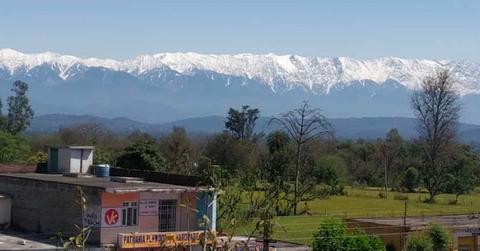Himalayas Visible From 100 Miles Away as Air Quality Improves During Coronavirus Lockdowns
India's drastic air quality improvements have cleared up skies, making the Himalayan mountains visible from more than 100 miles away.
Updated April 29 2020, 4:54 p.m. ET
With cities all over the world on lockdown due to COVID-19, researchers have measured reduced air pollutants in numerous areas, and people are noticing improved air quality everywhere from Italy to the U.S. to China. And now, India's reduced air pollution has caused something else pretty remarkable: People in Punjab can now see the Himalayan mountains, more than 100 miles away.
The Himalayas are visible from Punjab for the first time in 30 years.
Punjabis shared photos of the incredible view on Twitter. According to Manjit Kang, who lives in the state of Punjab, this was the first time the air has cleared up enough to see the mountain range in nearly three decades.
"This was the view from our rooftop at home in Punjab India," Kang tweeted alongside photos of the Himalayas in view in the distance. "For the first time in almost 30 years could clearly see the Himalayas due to India’s lockdown clearing air pollution. Just amazing!"
Indian cricket player Harbhajan Singh saw a similar view from his rooftop in Jalandhar, Punjab, and he shared the photo of the miraculous sight with his 10.4 million followers. "Never seen [Dhauladhar] range from my home rooftop in Jalandhar," he captioned a photo of the Dhauladhar mountain range. "Never could imagine that’s possible. Clear indication of the impact the pollution has done by us to Mother Earth."
Punjabi locals tweeted photos they took from their homes of the mountain ranges.
Why has air pollution gone down during the coronavirus?
Most air pollution comes from humans burning fossil fuels. And with far less cars on the roads and far less businesses in operation, humans are burning less fossil fuels and therefore causing less air pollution.
Air pollution has gone down across India.
As we reported last week, India's capital, New Delhi, which is in one of the most polluted regions on Earth, has experienced a major reduction in air pollution during the coronavirus lockdowns. Between March 20 and 27, levels of the harmful air pollutants PM 2.5 and nitrogen dioxide (NO2) dropped by about 71 percent in New Delhi, according to government data shared by CNN. In fact, a report by the Indian government's Central Pollution Control Board (Ministry of Environment, Forest and Climate Change) found that air quality has improved in 85 Indian cities since lockdowns and curfews were put into place.
"I have not seen such blue skies in Delhi for the past 10 years," Jyoti Pande Lavakare, co-founder of the nonprofit Care for Air, told CNN. "It is a silver lining in terms of this awful crisis that we can step outside and breathe."
When the pandemic slows down and India's usual hustle and bustle resumes, experts believe that poor air quality will return, allowing the Himalayas to disappear back into the horizon. But perhaps once businesses are up and running again, innovators will have a newfound inspiration to help transition the world to a clean energy economy.
The best way to prevent contracting or spreading coronavirus is with thorough hand washing and social distancing. If you feel you may be experiencing symptoms of coronavirus, which include persistent cough (usually dry), fever, shortness of breath, and fatigue, please call your doctor before going to get tested. For comprehensive resources and updates, visit the CDC website. If you are experiencing anxiety about the virus, seek out mental health support from your provider or visit NAMI.org.
